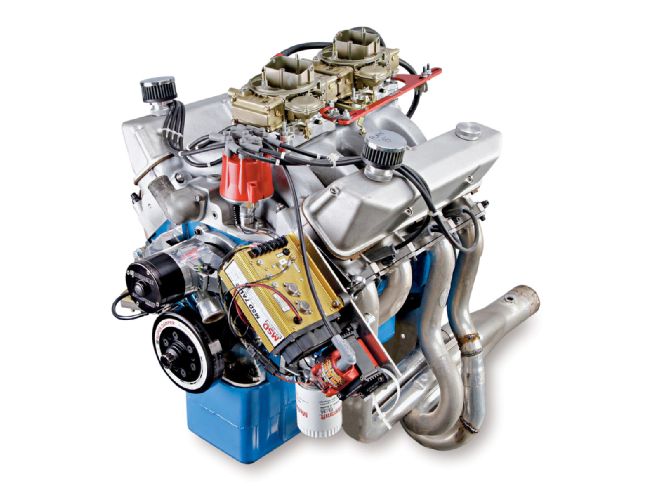
Barry Rabotnick is a survivor. From starting out as a Detroit street racer back in the day, to a long and varied career working for the big names in the automotive aftermarket like Holley and Speed-Pro, to finally ending up on his own with his aptly named Survival Motorsports, Barry's seen it all. Been there, done that, got the T-shirt, and worn holes in it. As much history as he's seen and been a part of, he's never been one to sit out and let a challenge pass, so when he was once again accepted to participate in the Popular Hot Rodding Engine Masters Challenge in 2009, he jumped in with both feet. Since Survival Motorsports' specialty is building high-output Ford engines, it was no surprise that he and friend, Tim Young, chose a race-inspired 433-cube FE engine as the basis for their pump-gas performer. Unfortunately, that decision was forced after their "Plan A" 427 SOHC engine ran into a minor issue with an excess amount of H2O entering the exhaust ports through a pinhole in one of the runners. Time for "Plan B," a high-riser FE made with leftovers, shelf parts, and very little sleep in the short time leading up to the Challenge.
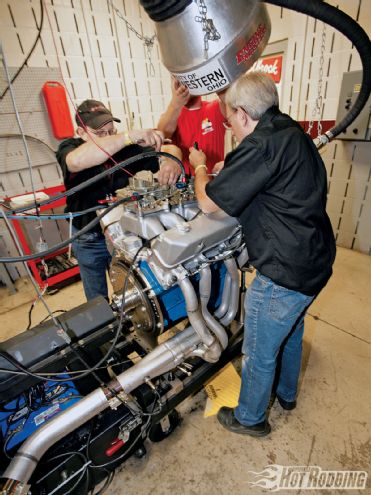
The first Ford FE engine came to life in 1958, along with the MEL engine family-kind of like Ford's version of a Chevy 409-as the big-blocks that would propel the larger, higher-end members of the Ford family. While the MEL (Mercury-Edsel-Lincoln) enjoyed a modest life most popular in the early '60s Lincoln Continentals, they quickly bowed out to leave the FE as the premier Ford engine. The FE and its heavy-duty truck brother, the FT, eventually found their way into everything from high-end Cobra Jet Mustangs, down to lowly dump trucks and the infamous Edsels. In fact, the moniker FE is derived from the names Ford-Edsel. The engines had one of the widest varieties of bore and stroke combinations of any engine family, from any brand. Displacements of 332, 352, 360, 361, 390, 391, 406, 410, 427, and 428 ci were possible. The blocks carried over some cues from their uncle, the Y-block family, that gained fame pushing the mid-'50s T-birds down the local cruise, à la Suzanne Somers in American Graffiti. Fully skirted blocks that rigidly supported the crankshaft, and shaft-mounted rockers were the most obvious connections between the two families.
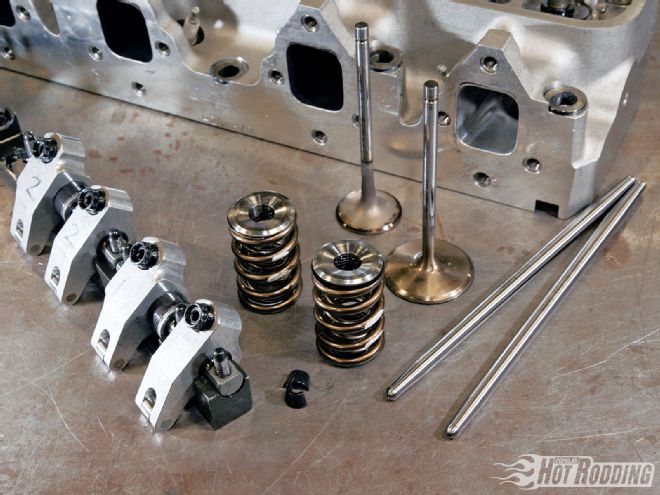 The backward 4160s were temporarily set up as mechanical secondary carbs by wedging zip ties in the linkage. It's an old trick that works for dyno testing, but for the streets a low-tension spring in the secondary pot will open the blades as quickly as the car needs.
The backward 4160s were temporarily set up as mechanical secondary carbs by wedging zip ties in the linkage. It's an old trick that works for dyno testing, but for the streets a low-tension spring in the secondary pot will open the blades as quickly as the car needs.
Knowing the ins and outs of these engines and their potential for power, Barry rooted through his shop and dug out an aftermarket Genesis block as the foundation for the project. Much easier to find than an original side-oiler block and with a passel of upgrades over the OE blocks, the Genesis was an easy choice. The block was torque plate honed to 4.350 inches, still leaving the cylinder walls over a quarter-inch thick to handle whatever power might come its way. "These blocks have Siamese bores and that is the only reason you can take them as big as you can. Real 427s come as 4.233, and you play hell trying to take them any bigger than .030- or .040-over because of the wall thickness," Barry says. The oiling system on the block shares the same design as the famous 427. A long passage is cast down the driver side of the engine to feed the main bearings directly rather than after feeding the cam, as did the other FEs. Typical prep work for a build using a stock block would include opening the oil passages and inlet/outlet to the filter and pump, as well as radiusing the many sharp edges and turns in the system. The Genesis block comes with these pinch points already opened up, and minor cleanup is about the only work left for a top-notch system. The Genesis is also set up to accept hydraulic lifters, thanks to some additional machine work not performed on the OE blocks, though a solid-roller cam was in the works here. The Survival team fed oil down those passages with the help of a blueprinted Melling oil pump. "It's a standard-volume pump with some porting, prep work, and detailing." Throughout the dyno pulls, the oil pressure maintained an evenly climbing 40-50 psi. Builders often make the choice to use a high-volume/high-pressure pump just because they like to see 80 psi at idle. Pegging the gauge like that is a sure way to know that a major portion of the oil is merely recirculating in the pump as it bypasses, heating it up and aerating it unnecessarily. Maintaining enough pressure to keep a hydrodynamic wedge on the bearings and lubricate the valvetrain is critical, but any more than that is wasting horsepower.
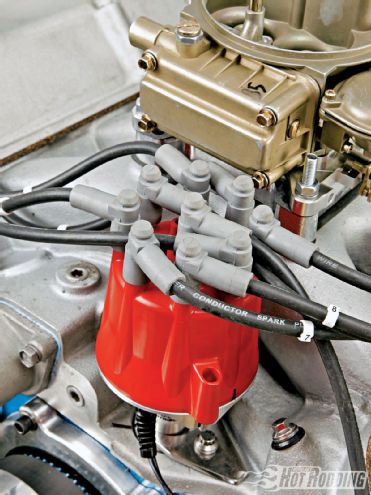 MSD's Pro Billet distributor is a bread-and-butter item in the world of high-performance engines. Some guys stuck on new technology aren't hip to the fact that individual cylinder timing has been done with these distributors for over 30 years by slightly bending the reluctor tangs to alter when the pickup reads it.
MSD's Pro Billet distributor is a bread-and-butter item in the world of high-performance engines. Some guys stuck on new technology aren't hip to the fact that individual cylinder timing has been done with these distributors for over 30 years by slightly bending the reluctor tangs to alter when the pickup reads it.
Robotnick was adamant that the "stock" crank floating on that hydrodynamic wedge was anything but stock. "It's got an Adney Brown Ford 391 truck crankshaft in it. It is a forged-steel Ford crankshaft that came out of a pickup truck, or more likely a dump truck. Adney at Performance Crankshaft [a fellow EMC competitor] really worked that one over hard. It's been destroked. It's a 3.64 stroke, which is exactly the opposite of what everyone does to crankshafts these days. That motor is the big-bore, short-stroke approach to 433 inches." Adney added to the aerodynamics of the shaft, bullnosing the leading edge and knife-edged the trailing edge of the counterweights. The crank was internally balanced to keep as much weight as close to the center of the crank as possible. Though an externally balanced crank performs well in moderate applications, the added offset weight on the balancer and flywheel of an externally balanced engine tends to whip the crank around like a pair of jump ropers swinging their ends of the rope out of sync. Not good for bearings or stress cracks in the crank.
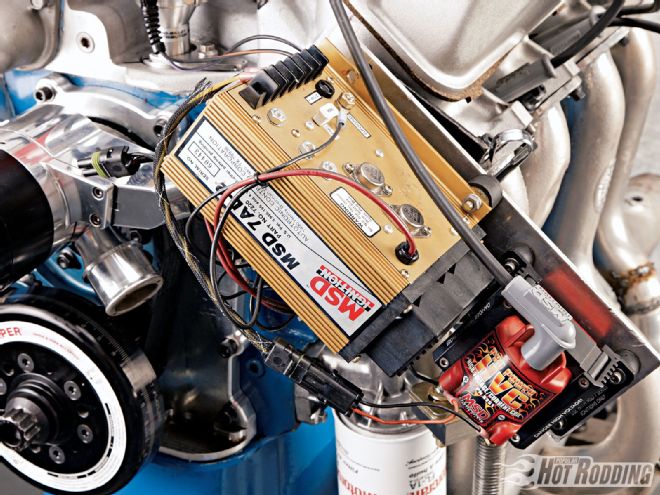 A 7AL2 box from MSD is probably in 80 percent of dragsters in this country. With the easy-to-access terminal strip and plug-in rpm modules, it is super easy to change your leave rpm and rev limit, and you'll never want for more spark.
A 7AL2 box from MSD is probably in 80 percent of dragsters in this country. With the easy-to-access terminal strip and plug-in rpm modules, it is super easy to change your leave rpm and rev limit, and you'll never want for more spark.
Barry's previous life as product line manager for Federal Mogul's performance division for 12 years gave him the inside line on whose performance parts really worked. He literally wrote the book on bearings (he was responsible for the Speed-Pro and Fel-Pro catalogs that are still on shelves today) so it was no problem determining that Federal Mogul would be his choice of bearings for the build. A set of leftover Carillo rods was a perfect match for the combo. Don't you wish you had a set of "leftover" Carillos? They were built for him by Jack Sparks and are set up for Chevy 283 rod journals. On the end of the rods swing a set of JE pistons with an inverted spherical dome. Barry felt the design he used would more evenly distribute the combustion pressure down through the piston than a common dish piston design. "It's a spherical dish and then we moved the valve pockets because this set of cylinder heads has been relocated on the block quite a bit. We're approaching an eighth of an inch move on the block." Shifting the heads upward or side to side to more efficiently locate the valves over the cylinder bores is not uncommon in high-performance builds like this, and .015 and .030 offset dowels are available from suppliers like Moroso for various engines. Barry's massive relocation, however, required custom dowel pins and elongating the boltholes in the heads for clearance.
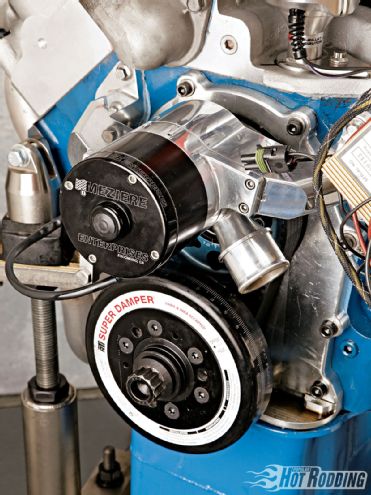 A Meziere electric water pump keeps the coolant flowing freely and the temperature of the cylinders consistent. Even temps allowed Rabotnick to dial in the most timing that would give the best power without running into detonation.
A Meziere electric water pump keeps the coolant flowing freely and the temperature of the cylinders consistent. Even temps allowed Rabotnick to dial in the most timing that would give the best power without running into detonation.
With the heads located properly, Barry and Tim made sure they had no clearance issues with the pistons and that the valve notches were not going to get too close to the ring grooves. As his past experience taught him the value of good rings, he naturally had Speed-Pro rings on those pistons. He was unable to gas-port the pistons per rules of the Challenge, so instead, he ordered his pistons designed for Dykes rings. Traditionally used in blown alcohol or nitro engines, the Dykes rings are L-shaped, using a fairly wide face to seat against the cylinder wall and a thin base sliding into the ring groove. The benefits of such a setup are that the hot combustion gasses can easily get behind the lip on the ring and shove it against the cylinder wall hard and fast while maintaining the lower tension of a thinner ring when not on the combustion cycle. When we asked how he felt about the rings, Barry says: "It was something I wanted to try a couple years ago. If I was going to build the motor now, I would probably put an .043 ring package in it, which is a more conventional race ring. The .043 rings tend to be machined better because they're flat on both sides. Now the Dykes, at least in theory, have an advantage in terms of sealing when you're not allowed to run a gas port. I thought the pressure loading of the Dykes ring would help seal it up." Running a conventional flat ring without gas ports, the builder doesn't have the opportunity to really tighten up the vertical clearance that keeps the rings from fluttering. Although it sounds like splitting hairs, getting the maximum from the rings is a trait that pro engine builders like Barry keep rattling around in their heads when designing a combination. Is it the end-all to get the ultra high-dollar ring package? "I think the differences between really decent ring packs are incremental. The differences between the rings are single-digit horsepower, maybe two at the very most. Anyone who thinks you are going to pick up 30 or 40 hp with a piston ring set is just kidding themselves. The big horsepower in Engine Masters, or anything else, is in the cylinder heads, camshaft, and intake manifold. It's airflow management."
 During the EMC's 20-minute tuning period, Barry and Tim just did a minor jet change and were happily surprised with the power the engine made.
During the EMC's 20-minute tuning period, Barry and Tim just did a minor jet change and were happily surprised with the power the engine made.
Controlling the pulse of the airflow through the engine is a COMP Cams camshaft that was designed specifically for the real-world 3,000- to 7,000-rpm range that this engine lives in. In fact, Barry actually ordered the cam for use in his personal street car. With duration not stratospheric, and lift under .700-inch, it is a cam that would not destroy the valvetrain if the engine were put on the streets of Detroit. A Danny Bee beltdrive sits in place of the normal timing chain, and allows Barry to tune the cam timing events to best match the needs of his combination. "They [Danny Bee] are the only ones who do an FE belt drive. It's fortunate that it's a really nice part because it's the only one we have to choose from. They replace the entire front cover with a piece of billet aluminum, and it's pretty slick. It gives us a level of tuning flexibility, which has never been matched before. I can do cam timing changes in minutes that used to take hours." Running a 110-degree lobe separation on the cam, it was quick work to advance it for best power in the competition.
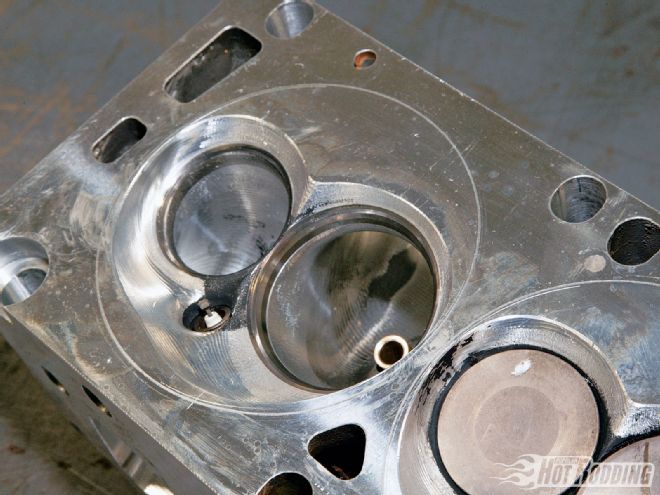
Perched on the built short-block is a pair of Blue Thunder cylinder heads. The heads are based on the "high-riser" design that Ford built as an over-the-counter race head in 1964. The intake runners towered almost a full inch higher than standard FE heads, and unless you had pockets deep enough for NASCAR-style Tunnel-Port heads, were the ultimate in FE wedge heads. The in-your-face design of the high-risers was made specifically for racers, since with their height and requirement for a special intake manifold, they would not clear a stock flat hood. The theory behind the head was not only to increase runner volume, but to give it more of a straight shot down the throat of the engine and into the chamber. With the scarcity and desire for these heads, it was no surprise that Blue Thunder went to the trouble of casting a newer, more up-to-date version. More than 40 years of technology has allowed the Blue Thunder High-Risers to be significantly improved over the initial design. Barry credits Cary Chouinard and John Marcella with the performance of the heads. "The port development and valve job development was done by John, and then Cary was the one who CNC'd it." Those names might sounds familiar as they were the team who built ET Performance. Cary now runs Performance Induction, and John's Marcella Manifolds is growing rapidly. They gave the heads an efficient heart-shaped wedge combustion chamber with a more centralized spark plug placement that assured a homogenized burn and decreased any chances of detonation-especially critical considering the small chambers gave the engine 11.5:1 compression, and it was fed 91-octane unleaded dinosaur juice. Ferrea 5/16-inch stem valves were lightweight enough to reduce the spring requirements, and cut with a 52-degree valve job to really make the flow numbers pop. Manley's Nextec oval-track springs had modest spring pressure, and were built to last in an endurance application, so they held up just fine in the street-oriented buildup. Barry is a believer that on the pushrod side of the rocker, stiffness is more important than weight, so when he called Trend for his pushrods he ordered them as a double-taper running from to 7/16 inch in a super-thick .165-inch wall thickness.
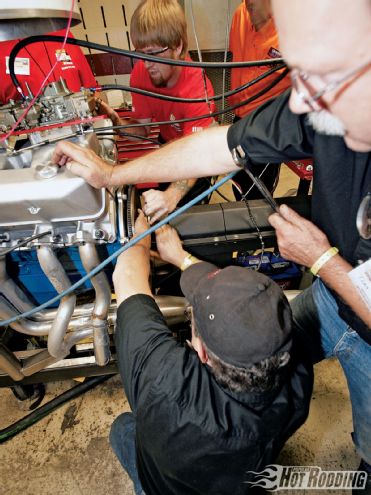 Crash! On the final tuning pull, the dyno operator noticed a bad rattling noise, and with the help of the UNOH students, they figured out the flywheel bolts had come loose. They had to unhook the engine,retorque the bolts and get it going again, all the while dipping into their tuning time.
Crash! On the final tuning pull, the dyno operator noticed a bad rattling noise, and with the help of the UNOH students, they figured out the flywheel bolts had come loose. They had to unhook the engine,retorque the bolts and get it going again, all the while dipping into their tuning time.
The heads took advantage of a feature found in the 428 CJ castings as well. Dual bolt patterns on the exhaust side allowed a variety of headers to fit them and give easy access to the header bolts for at-the-track removal. Big valves are a given for a combo like this, and though some bore chamfering would be required on a standard 390 or 428 block, the large bore of this 433 easily swallowed the 2.20/1.71-inch stainless steel poppets.
Because high-riser heads use larger valves than their little brothers, they had their own special rocker shaft supports. To keep the same rocker arm height as the standard- and medium-riser heads, they were shorter since the ports were so tall, but also wide since the big valves required different valve spacing. This is critical to note if you were, say, to spot a set at the local swap meet for sale that didn't have the matching stands. Barry bypassed the mixing and matching dilemma by bolting on a set of 1.9 ratio rockers built by T&D Machine. Solid-lifter factory engines came with 1.76-ratio adjustable rocker arms, and hydraulic-lifter engines were equipped with milder 1.73-ratio rockers. The extra ratio in Barry's T&D rockers not only gave the engine more max lift, but really snapped the valves open and closed quickly, taking the most advantage of the heads.
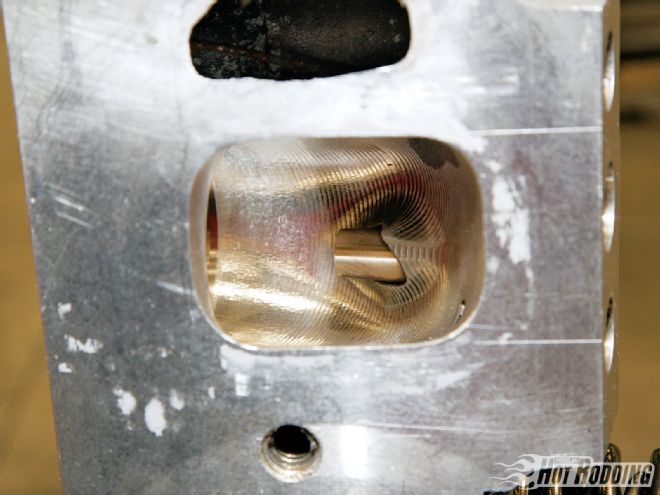 The CNC-machined runners were good enough to run without any work beyond a touch of cartridge rolling at the valve job. A call to Survival Motorsports can get you a set of these for your '70 Mustang.
The CNC-machined runners were good enough to run without any work beyond a touch of cartridge rolling at the valve job. A call to Survival Motorsports can get you a set of these for your '70 Mustang.
Dove manufactured the dual-carb intake for the high-riser heads that was also intended for use on Barry's street car. "It was port matched to the heads, but it has almost no other modifications to it. There's no plenum work, nothing trick in the intake at all. I just port matched it to the heads and bolted it on. And it performed surprisingly well. It's a tunnel wedge, which Ford never made. They made a tunnel wedge for a medium-riser intake, and Dove did a variation that would fit a high-riser head." The design is sort of a combination of two single-planes joined by an open plenum.
Reaching back into history once again, Barry contacted his old friends Marty Brown and Marvin Benoit at Quick Fuel, who built him a pair of matched vacuum-secondary carburetors that Survival sells as a vintage-looking setup. "We sell those as reproduction carbs for guys building Mustangs and Galaxies who want to run the factory intake manifold. The way the factory intakes are made-the 427 intakes-you cannot put a 4150-style carb on there because there's just not enough room on top of the motor for the distributor. So what Ford did was they put the carburetors on backward, and they used a 4160 carb. The 4160 does not having metering blocks, so it shortened it up because the bowl bolts straight to the main body. Then you put it on backward, and it gives you the shortest possible distance between the distributor and the carburetor." The Quick Fuel carbs look "reproductiony" on the outside without any of the modern billet doodads, but inside they have all the latest emulsion bleeds, downleg boosters, stainless butterflies with button head screws and slabbed shafts. Everything that would make them perform at the peak of today's performance, but with yesterday's aesthetic. As far as tuning, Barry says: "They literally came out of the box. We bolted them to the motor, and we did like two jet changes and ran it. For the purposes of the dyno we used some wire ties to mechanically open the secondaries to make sure they were open. I was worried about them coming open fast enough for the dyno pull." On dyno pulls where the engine is held at full load, then drawn down to a low starting rpm, it can be a little tricky sometimes getting vacuum secondary carbs to act just right, but for street purposes the old trick of mechanically opening the secondaries isn't necessary. Traction at the wheels would give up long before it would be possible to bog this powerhouse down, considering the 550 lb-ft on tap.
 The CNC-machined runners were good enough to run without any work beyond a touch of cartridge rolling at the valve job. A call to Survival Motorsports can get you a set of these for your '70 Mustang.
The CNC-machined runners were good enough to run without any work beyond a touch of cartridge rolling at the valve job. A call to Survival Motorsports can get you a set of these for your '70 Mustang.
The students at the University of Northwestern Ohio where the EMC took place bolted the engine to one of two DTS dynos, attached the Hooker headers and Magnaflow mufflers to 13 feet of exhaust pipe, and woke the animal. After a five minute warm-up period, the dyno operator dropped the hammer on Barry's beast. Three back-to-back pulls later, the engine made so much torque that it rattled the flywheel bolts loose. Critical time was spent unhooking the dyno cart and sliding it forward to allow the fix, then it was back for duty. Though a bad electrical connection that surfaced during the flywheel thrash kept the "Plan B" engine from revving above six grand, it proved to be an incredible exercise showing that it doesn't take a year to build a 670hp pump-gas engine. It could be done in a couple weeks with the right parts, the right mindset, and friends who won't let you quit when "Plan A" goes to hell.
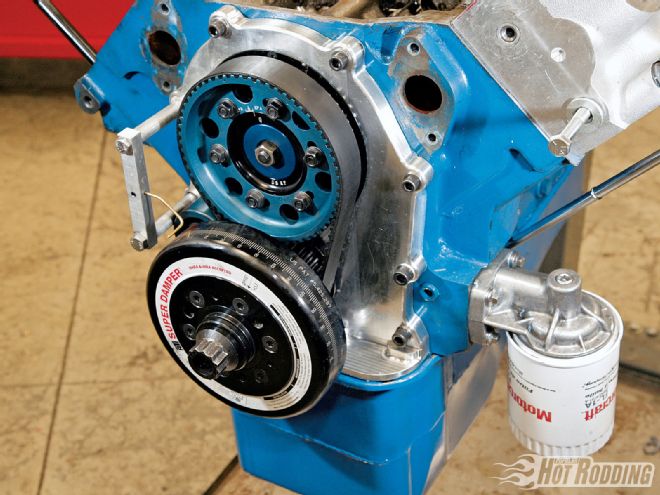 COMP Cams ground the bumpstick that powered the engine, and it was trued up in time with a Danny Bee beltdrive. A fully degreed ATI harmonic dampener was honed to the appropriate press fit on the crank snout, and true top dead center was marked with the "custom" adjustable timing pointer.
BY THE NUMBERS
433ci Ford FE
Bore:
4.350-inch
Stroke:
3.640-inch
Displacement:
433 actual cubic inches
Compression ratio:
11.5:1
Camshaft:
COMP solid roller
Cam duration:
256/264 degrees
at .050-inch tappet rise
Valve lift:
.697/.697-inch
Rocker ratio:
T&D Machine 1.9 ratio
Top ring:
.017-inch Speed-Pro, Dykes
Second ring:
.043-inch Speed-Pro
Oil ring:
4mm Speed-Pro
Piston:
JE dished
Block:
Genesis
Crankshaft:
OEM
Rods:
Carillo 6.700 H-beam
Cylinder head:
Blue Thunder
Intake valve diameter:
2.200-inch
Exhaust valve diameter:
1.710-inch
Intake manifold:
Dove High-Riser
Carburetor:
Quick Fuel modified
Holley 4160 x 2
Header:
Hooker
Ignition:
MSD 7AL2
Damper:
ATI
DYNO DATA
RPM
TQ
HP
3,000
408
233
3,100
421
248
3,200
425
259
3,300
418
263
3,400
407
264
3,500
401
267
3,600
393
269
3,700
391
275
3,800
395
286
3,900
408
303
4,000
424
323
4,100
438
342
4,200
451
361
4,300
459
376
4,400
467
391
4,500
475
407
4,600
479
420
4,700
485
434
4,800
493
450
4,900
504
470
5,000
514
490
5,100
526
510
5,200
534
528
5,300
539
544
5,400
544
559
5,500
547
573
5,600
545
581
5,700
545
592
5,800
545
601
5,900
546
613
6,000
542
619
6,100
540
627
6,200
537
633
6,300
534
641
6,400
529
645
6,500
527
652
6,600
523
657
6,700
521
664
6,800
514
665
6,900
510
670
7,000
500
667
COMP Cams ground the bumpstick that powered the engine, and it was trued up in time with a Danny Bee beltdrive. A fully degreed ATI harmonic dampener was honed to the appropriate press fit on the crank snout, and true top dead center was marked with the "custom" adjustable timing pointer.
BY THE NUMBERS
433ci Ford FE
Bore:
4.350-inch
Stroke:
3.640-inch
Displacement:
433 actual cubic inches
Compression ratio:
11.5:1
Camshaft:
COMP solid roller
Cam duration:
256/264 degrees
at .050-inch tappet rise
Valve lift:
.697/.697-inch
Rocker ratio:
T&D Machine 1.9 ratio
Top ring:
.017-inch Speed-Pro, Dykes
Second ring:
.043-inch Speed-Pro
Oil ring:
4mm Speed-Pro
Piston:
JE dished
Block:
Genesis
Crankshaft:
OEM
Rods:
Carillo 6.700 H-beam
Cylinder head:
Blue Thunder
Intake valve diameter:
2.200-inch
Exhaust valve diameter:
1.710-inch
Intake manifold:
Dove High-Riser
Carburetor:
Quick Fuel modified
Holley 4160 x 2
Header:
Hooker
Ignition:
MSD 7AL2
Damper:
ATI
DYNO DATA
RPM
TQ
HP
3,000
408
233
3,100
421
248
3,200
425
259
3,300
418
263
3,400
407
264
3,500
401
267
3,600
393
269
3,700
391
275
3,800
395
286
3,900
408
303
4,000
424
323
4,100
438
342
4,200
451
361
4,300
459
376
4,400
467
391
4,500
475
407
4,600
479
420
4,700
485
434
4,800
493
450
4,900
504
470
5,000
514
490
5,100
526
510
5,200
534
528
5,300
539
544
5,400
544
559
5,500
547
573
5,600
545
581
5,700
545
592
5,800
545
601
5,900
546
613
6,000
542
619
6,100
540
627
6,200
537
633
6,300
534
641
6,400
529
645
6,500
527
652
6,600
523
657
6,700
521
664
6,800
514
665
6,900
510
670
7,000
500
667